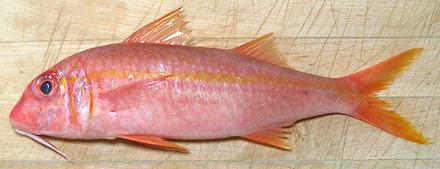 [Red Weke; Mulloidichthys dentatus]
[Red Weke; Mulloidichthys dentatus]
This Eastern Pacific Goatfish is found from Southern California to Peru, but is rare north of the southern tip of Baja and south of Panama. The photo specimen is in its night time colors, during the day it is white with yellow stripes. It is often marketed in its red form, which can be somewhat blotchy. Note that the barbels responsible for the name "goatfish" can be tucked in and may not be visible. These fish can grow to 12 inches but the photo specimen was 11-1/2 inches long and weighed 1l-1/4 ounces. It was purchased from a Philippine market in Los Angeles at 2014 US $7.99 per pound, Labeled "Red Weke / Mexican Goatfish". Red list status: LC (Least Concern).
The name Red Weke, according to fishbase, properly belongs to the Yellowfin Goatfish (Mulloidichthys vanicolensis) and Orange goatfish (Mulloidichthys pfluegeri), two Indo-Pacific fish that very much resemble the Mexican Goatfish when in their red phase, making positive identification difficult.
More on Goatfish.
Mexican Goatfish is an excellent eating fish. Its flesh is mild, firm and white, suitable for most method of cooking. Its unique flavor is most enjoyable poached, but it is also very fine pan fried with just a dusting of rice flour. Use a very light sauce. The flesh is firm enough to use for soups, but should be added near the end of cooking. I don't cook this fish whole because of the many large centerline pin bones, other small bones associated with the fins, skin shrink and difficulty making sure all the transparent scales have been removed. These factors make it difficult to deal with at the table.
Buying: So far I have found this fish only in a Philippine market in Los Angeles, displayed on ice. It is not common - you just buy it when you see it.
Scales: This fish is covered with very large but rather thin scales that scrape off fairly easily with very little flying about. Some may simply fold over, but are easy to pull off with your fingers. The main problem is they are very transparent and making sure you've rinsed them all off the fish is not easy.
Cleaning: This fish has a small body cavity and is easy to clean, but the throat is so strong you'll have to cut it with shears. The gills pull out fairly easily.
Fillets: This is an easy fish to fillet but the short rib cage is difficult to follow. When you get to the rib cage just use your kitchen shears to cut the ribs from the backbone and use long nose pliers to pull them from the fillet. There are also many very significant centerline pin bones which need to be pulled for the front 2/3 of the fillet. They are easy to find in the soft flesh, just pull them straight forward with long nose pliers.
Yield: Fillet yield is moderate due to the fish's large head, an 11-1/2 ounce fish yielded 5-3/4 ounces skin-on fillet (50%) and 5-1/8 ounces of skinless fillet (45%).
Skin: The skin of this fish does not have a strong or "off" flavor but it does shrink quite a bit. You can easily pan fry fillets skin-on, just fry on the non-skin side, then flip the fillet and hold it flat with your turner. For poaching, the skin needs to be removed because, though the skin is not strong, neither is the flesh, so it will curl up. Once cooked, the skin is nearly non-existent.
This fish is not easy to skin because the skin is so thin and fragile. Using the standard Method, You have to hold the long knife at as shallow an angle as you can without taking flesh, and you'll still probably end up with fairly large patches of skin remaining. If it breaks half way, start over from the tip of the fillet at the top. Don't worry about modest size patches, they'll cause no trouble, but if you have a really big patch, you may be able to get under the transparent outer membrane and pull it off - that's the part that shrinks, not the color layer under it.
Stock: The heads, fins, bones and skins make an excellent light flavored stock suggestive of shrimp (see Method). There is little oil, but remove what there is using your gravy separator.
sf_goatcbz 141101 - www.clovegarden.com